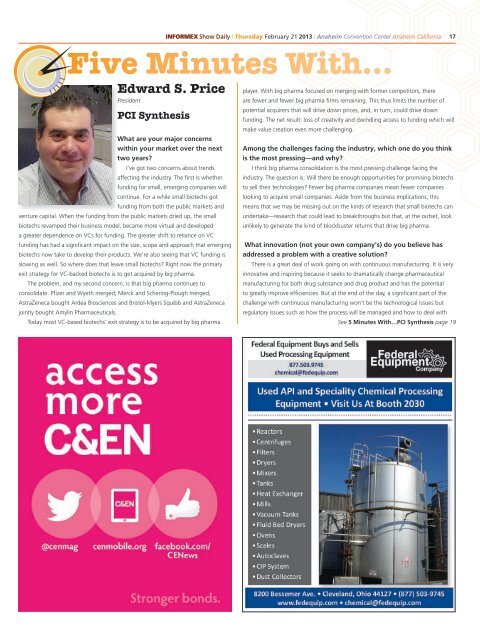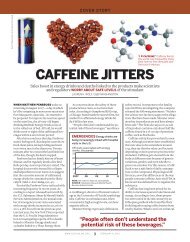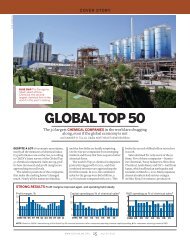Thursday - Chemical & Engineering News - American Chemical ...
Thursday - Chemical & Engineering News - American Chemical ...
Thursday - Chemical & Engineering News - American Chemical ...
Create successful ePaper yourself
Turn your PDF publications into a flip-book with our unique Google optimized e-Paper software.
INFORMEX Show Daily | <strong>Thursday</strong> February 21 2013 | Anaheim Convention Center Anaheim California 17<br />
Five Minutes With…<br />
Edward S. Price<br />
President<br />
PCI Synthesis<br />
What are your major concerns<br />
within your market over the next<br />
two years<br />
I’ve got two concerns about trends<br />
affecting the industry. The first is whether<br />
funding for small, emerging companies will<br />
continue. For a while small biotechs got<br />
funding from both the public markets and<br />
venture capital. When the funding from the public markets dried up, the small<br />
biotechs revamped their business model, became more virtual and developed<br />
a greater dependence on VCs for funding. The greater shift to reliance on VC<br />
funding has had a significant impact on the size, scope and approach that emerging<br />
biotechs now take to develop their products. We’re also seeing that VC funding is<br />
slowing as well. So where does that leave small biotechs Right now the primary<br />
exit strategy for VC-backed biotechs is to get acquired by big pharma.<br />
The problem, and my second concern, is that big pharma continues to<br />
consolidate. Pfizer and Wyeth merged; Merck and Schering-Plough merged;<br />
AstraZeneca bought Ardea Biosciences and Bristol-Myers Squibb and AstraZeneca<br />
jointly bought Amylin Pharmaceuticals.<br />
Today most VC-based biotechs’ exit strategy is to be acquired by big pharma<br />
player. With big pharma focused on merging with former competitors, there<br />
are fewer and fewer big pharma firms remaining. This thus limits the number of<br />
potential acquirers that will drive down prices, and, in turn, could drive down<br />
funding. The net result: loss of creativity and dwindling access to funding which will<br />
make value creation even more challenging.<br />
Among the challenges facing the industry, which one do you think<br />
is the most pressing—and why<br />
I think big pharma consolidation is the most pressing challenge facing the<br />
industry. The question is: Will there be enough opportunities for promising biotechs<br />
to sell their technologies Fewer big pharma companies mean fewer companies<br />
looking to acquire small companies. Aside from the business implications, this<br />
means that we may be missing out on the kinds of research that small biotechs can<br />
undertake—research that could lead to breakthroughs but that, at the outset, look<br />
unlikely to generate the kind of blockbuster returns that drive big pharma.<br />
What innovation (not your own company’s) do you believe has<br />
addressed a problem with a creative solution<br />
There is a great deal of work going on with continuous manufacturing. It is very<br />
innovative and inspiring because it seeks to dramatically change pharmaceutical<br />
manufacturing for both drug substance and drug product and has the potential<br />
to greatly improve efficiencies. But at the end of the day, a significant part of the<br />
challenge with continuous manufacturing won’t be the technological issues but<br />
regulatory issues such as how the process will be managed and how to deal with<br />
See 5 Minutes With…PCI Synthesis page 19















